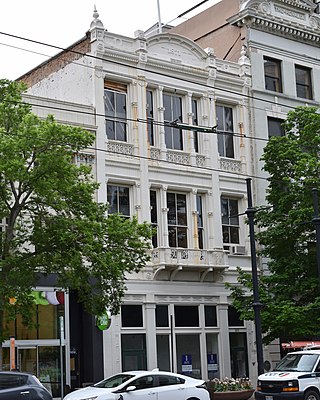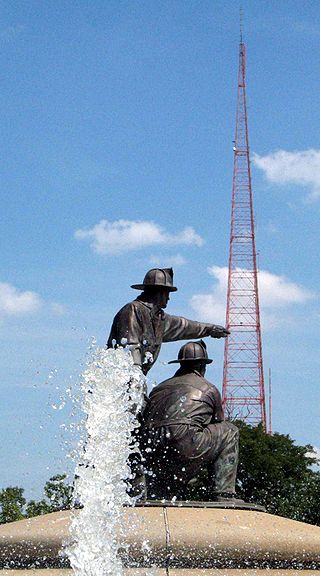
Park City is a city in Utah, United States. The vast majority is in Summit County with some portions extending into Wasatch County. It is considered to be part of the Wasatch Back. The city is 32 miles (51 km) southeast of downtown Salt Lake City and 20 miles (32 km) from Salt Lake City's east edge of Sugar House along Interstate 80. The population was 8,396 at the 2020 census. On average, the tourist population greatly exceeds the number of permanent residents.

Salt Lake City, Utah has many historic and notable sites within its immediate borders. Although the entire Salt Lake City metropolitan area is often referred to as "Salt Lake City", this article is concerned only with the buildings and sites within the official city limits of Salt Lake City.

Downtown is the oldest district in Salt Lake City, Utah, United States. The grid from which the entire city is laid out originates at Temple Square, the location of the Salt Lake Temple.

Trolley Square is a partially enclosed shopping center located in Salt Lake City, Utah, United States. It is considered to be a trendy high-end center. The center is near downtown Salt Lake City and the UTA TRAX light-rail system.

The economy of Salt Lake City, Utah is primarily service-oriented. While nearby Bingham Canyon Mine provided a strong source of income during the 19th century, the city has evolved to an economy built on transit hubs, call centers, and seasonal tourism. The 2002 Olympic Winter Games gave a great boost to the area's economy. Many hotels and restaurants were built for the 2002 Olympics, and although many survive, they have suffered post-Olympic market saturation.

The Canada Life Building is a historic office building in Toronto, Ontario, Canada. The fifteen-floor Beaux Arts building was built by Sproatt & Rolph and stands at 285 feet (87 m), 321 feet (97.8 m) including its weather beacon.

The Gulf Tower is a 44-story, 177.4 m (582 ft) Art Deco skyscraper in downtown Pittsburgh, Pennsylvania. The tower is one of the major distinctive and recognizable features of the city and is named for the Gulf Oil Corporation.

Because it was positioned near the busy shipping lanes of the mid-19th century, a lighthouse was built on Granite Island in 1868 by the U.S. Lighthouse Board and commissioned in 1869.

A weather beacon is a beacon that indicates the local weather forecast in a code of colored or flashing lights. Often, a short poem or jingle accompanies the code to make it easier to remember.

The Berkeley Building is a 26-story, 495-foot (151 m) building located at 200 Berkeley Street, Boston, Massachusetts, USA. It is the second of the three John Hancock buildings built in Boston; it was succeeded by the John Hancock Tower. The building is known for the weather beacon at its summit, which displays distinctive light patterns as weather forecasts. The Berkeley Building is the 25th-tallest building in the city.

The Mercantile National Bank Building is a 31-story, 159.4 m (523 ft) skyscraper at 1800 Main Street in the Main Street district of downtown Dallas, Texas. It is the former home of the Mercantile National Bank, which later became MCorp Bank. The design of the skyscraper features Moderne styling from the Art Deco era and was designed by Walter W. Ahlschlager. The building has a series of setbacks that is crowned by an ornamental four-sided clock along with a decorative weather spire. The Merc was the main element of a four-building complex that eventually spanned a full city block.

The 320 South Boston Building is a 22-story high-rise building located in downtown Tulsa, Oklahoma. It was originally constructed at the corner of Third Street and Boston Avenue as a ten-story headquarters building for the Exchange National Bank of Tulsa, Oklahoma in 1917, and expanded to its present dimensions in 1929. The addition brought the building's height to 400 feet (122 m), making it the tallest building in Oklahoma. It lost this distinction in 1931, but remained the tallest building in Tulsa until Fourth National Bank was completed in 1967. It is now included in the Oil Capital Historic District.
In weather forecasting in the United States, "particularly dangerous situation" (PDS) is enhanced wording used by the National Weather Service to convey special urgency in some watch or warning messages for unusually extreme and life-threatening severe weather events, above and beyond the average severity for the type of event. It is used in the format "This is a particularly dangerous situation..." at the discretion of the issuing forecaster. A watch or warning bearing the phrase is referred to as a PDS watch or PDS warning as shorthand jargon.

The U-Drop Inn, also known as Tower Station and U-Drop Inn and Tower Café, was built in 1936 in Shamrock, Texas along the historic Route 66 highway in Wheeler County. Inspired by the image of a nail stuck in soil, the building was designed by J. C. Berry. An unusual example of art deco architecture applied to a gas station and restaurant, the building features two flared towers with geometric detailing, curvilinear massing, glazed ceramic tile walls, and neon light accents. It has traditionally held two separate business: "Tower Station," a gas station on the western side, and the "U-Drop Inn," a café on the eastern side. Though it has passed hands several times in its history, the building has consistently housed the same types of businesses it was originally constructed for.

1740 Broadway is a 26-story building on the east side of Broadway, between 55th and 56th Streets, in the Midtown Manhattan neighborhood of New York City. The building is owned by EQ Office and shares a city block with the Park Central Hotel.

The Michigan Bell and Western Electric Warehouse is a former commercial warehouse building located at 882 Oakman Boulevard in Detroit, Michigan. It was listed on the National Register of Historic Places in 2009. It is now known as the NSO Bell Building.

Old Main was the first building built on the campus of the Agricultural College of Utah, now Utah State University. It sits at the top of Old Main Hill, overlooking the city of Logan to the west, and facing the quad to the east. Old Main is the oldest functioning academic building in Utah.

The First National Bank is a historic bank building in downtown Salt Lake City, Utah, United States, that is listed on the National Register of Historic Places (NRHP).

KC-TVTower is a 1,042-foot (318 m) high freestanding steel lattice tower located at East 31st Street on Union Hill in Kansas City, Missouri, United States.



















